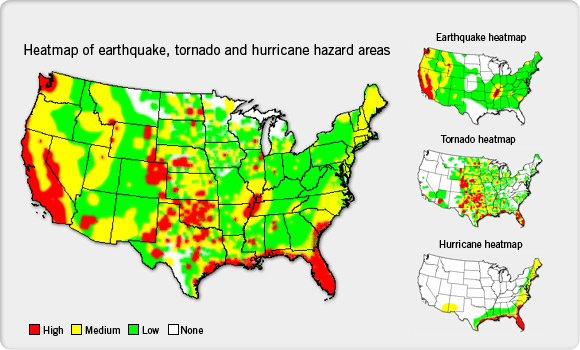If Mother Nature has anything to say, there simply are some places where you shouldn’t place a data center. Do you really want to have your servers where there is a high risk of earthquakes, tornadoes or hurricanes? We didn’t think so…
It seems that the U.S. is “blessed” not only with large areas where the likelihood of earthquakes is very high, but also with some very harsh weather conditions in the form of hurricanes (no one is going to forget Katrina) and tornadoes, the most violent weather phenomenon in nature. Power outages, breakdown of infrastructure and loss of lives follow in the tracks of these hazardous monstrosities of nature.
We decided to look at heat maps for earthquakes, hurricanes and tornadoes in the U.S. to see exactly where the danger areas were located. In addition to that we also composited them to see get the full picture.

States with large areas where there is either a very high risk of hurricanes, tornadoes or earthquakes are California, Florida, Washington, Arkansas, Texas, Colorado, Nebraska, South Carolina, Louisiana, Arizona, New Mexico.
If your biggest worry is weather, Florida has a very high risk of both hurricanes and tornadoes. If your biggest worry is earthquakes, California has been waiting for The Big One for quite some time now (hopefully not this bad, though). Silicon Valley is resting on wobbly ground.
There are a few areas in Montana, North Dakota, Minnesota, Wisconsin, Michigan and Texas where none of the three heat maps overlap. There may of course be other dangers aside from those we listed here.
We are not saying that everyone should move to Montana, but if you take earthquakes, hurricanes and tornadoes into account, you might want to keep your data center (or servers in general) outside the “red zones” of the map.
Sources: Data from U.S. Geological Survey, National Hurricane Center and National Climatic Data Center. Heat maps can be found here: Earthquake heat map, hurricane heat map, tornado heat map.
























